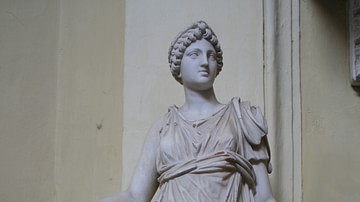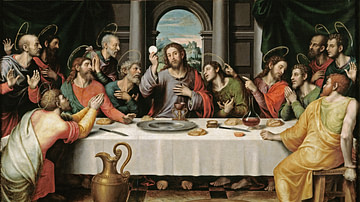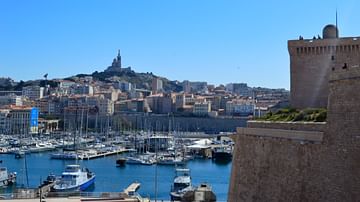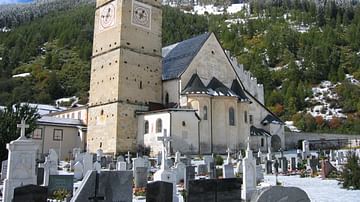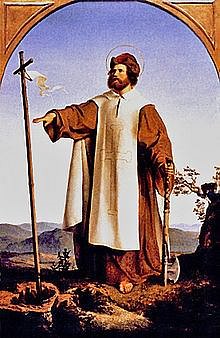
Saint Boniface (or in Dutch the Heilige Bonifatius) is one of the most famous saints in the Netherlands. His real name was Wynfreth and he lived from 672 until 754 CE. Pope Gregory II, who ruled from 715 to 731 CE, was at that time struggling with pagan Germanic tribes and, keen to convert them, Wynfreth offered Gregory the perfect opportunity to achieve this goal, the Christianization of Europe. After he received the name Boniface on the 5th of May 719 CE, which means 'he who does good', he served as a missionary in the first half of the 8th century and helped reorganize the church in Germany and the Frankish kingdom.
Early life
Boniface was born in southern England in the Essex region, probably near Exeter, and presumably Crediton. Descended from a noble family, from his earliest years he showed great ability and received a religious education. His parents intended him for secular pursuits, but, the young Wynfreth was inspired with higher ideals by missionary monks who visited his home. Consequently, he was, according to Celtic and Anglo-Saxon tradition, taken in at the monastery of Adescancastre. Such children as these were known as pueri oblate and in the monastery the children learned to read and write and became familiar with Roman civilisation. Even at this early age the young Wynfreth was both intelligent and eager to learn.
Beliefs & Teachings
In 705 CE Wynfreth was sent to the bishop Berthwalt of Canterbury. Here, leading an austere and studious life under Abbot Winbert, he rapidly advanced in sanctity and knowledge, excelling especially in a profound understanding of scriptures, of which he gives evidence in his letters. He also gained a reputation as a diplomat, teacher and preacher. His students, particularly nuns, were very pleased with his teachings. Wynfreth was, although still at a young age, well aware of the importance of a large network of acquaintances. His career at this time is well evidenced by his letters, and is plausibly, if partially, described in hagiographies by his disciples. A rather different account, however, is also provided by other texts almost equally early in date, some of which come somewhat closer to presenting Boniface as the missionary of the popular imagination.
Role in the Christianization of the Frisians
Much later in life, when Boniface was already 82 years old, he, nevertheless, undertook the journey to the Frisians in 716 CE to convert them to Christianity. Indeed, to him has been attributed the evangelisation of much of the land to the east of the Rhine: Hesse, Thuringia, and even parts of Bavaria. This is precisely what he wished to achieve. Yet the image is deceptive, for he was, in fact, less a missionary to the pagans than he himself had expected. Certainly, he went to the continent in 716 CE to become a missionary, and at the start and end of his continental career he did work among the pagans in Frisia. He also wished to evangelise the Saxons, because they were related to the English – a point which has already been made by Willibrord's biographer Ecgbert. For a brief moment in 737 CE it looked as if the victories of Charles Martel would open up Saxony as a mission field, and Boniface lobbied his Anglo-Saxon contacts for support in the expected enterprise. However, this would not go without a fight. In 721 CE, Boniface remembered his papal obilgations and moved back to Germania and worked in Hesse.
In 722 CE Boniface returned to Rome, and was there consecrated bishop, and was given letters of introduction to the leaders of the territories east of the Rhine, and especially to Charles Martel. On his return home he worked first in Hesse and then, further to the east in Thuringia. Within the areas, he was, for the most part, organising a somewhat unstructured and sometimes heretical group of Christian churches, rather than preaching to the pagans, even though it was the pagans who were his avowed objective. He is, however, recorded as having one spectacular showdown with a backwoods pagan community, at Geismar, where he cut down a great oak tree associated with 'Jupiter' or Donar. Miraculously, the tree came down easily, dividing into four pieces as it fell.
Fulda & the Murder of Boniface
Following the death of Charles Martel in 741 CE and the establishment of his sons, Pippin III and Carloman, in his place, Boniface turned his mind to reform the Frankish Church – notably in a series of synods held between 742 and 744 CE. In the course of the reform a number of established clerics came under scrutiny, among them Bishop Gewilib of Mainz, who was removed from office in 745 CE. A year later, Boniface himself was appointed in his place: although he had held the position of missionary bishop since 722 CE, he had not hitherto been the incumbent of a fixed diocese. Meanwhile, in 744 CE he founded the monastery of Fulda, almost on the border of Thuringia and Hesse, appointing the Bavarian Sturm as abbot, and subsequently putting it under papal jurisdiction. Fulda would be his most significant monastic foundation, not least because it became the burial place of Boniface himself. It was also to be a missionary centre and a number of manuscripts associated with his mission have been attributed to its scriptorium. More important, in the long run, would be its intellectual achievements in the 9th century CE.
Ultimately, having installed Lull as his successor at Mainz in 753 CE, Boniface returned to Frisia accompanied by 40 servants (pueri) and many Christian books and articles, Boniface converted thousands of Frisians, until they were overtaken by the Frisians on the 5th of June 754 CE and tortured to death. The servants were not allowed to defend themselves at Boniface's command, so they would be the first martyrs. This speaks against the claim that Boniface was the first martyr. He was perhaps the first bishop who was killed for faith, but Boniface would have defended himself. However, the previous assertion seems unlikely since his biographer Willibald describes nothing about the murder of Boniface and the servants were actually trained Frankish soldiers. They were well armed but were unlikely to outweigh the Frisian invasion force. It is also unclear whether the killers were pagan reactionaries or merely thieves. His body was buried in the monastery of Fulda.
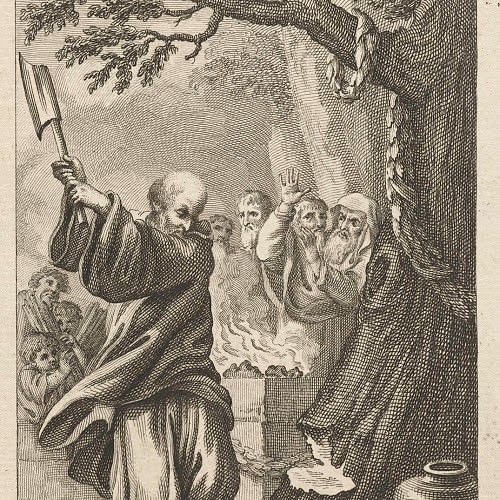
St. Boniface's Legacy & Influence in the Netherlands
After his death, Boniface received his own cult no different from the gods of ancient Greece and Rome. Like the Greek goddess of health Hygieia, Boniface even had his own spring and sacred relics. Through the centuries, many pilgrimages were taken to Dokkum to worship those relics. The most precious is a small piece of Boniface's skull. In the 16th century CE Boniface's relics included, according to the Dokkumer author Cornelius Kempius, the skull fragment, an ivory crook, a gold chalice, a chasuble, a cope and a gospel book personally written by Boniface himself, probably the Victor Codex from 546 CE Bishop Victor of Capua. Cornelius Kempius saw this codex and the other relics with his own eyes. They are, he describes, every seven years presented to the people.
After the rise of Protestantism and the plundering of the Dokkumer abbey in 1572 CE and its abolition in 1582 CE, the relics were scattered. Where they went is not clear. There is a tradition that says that the abbot of Fulda travelled to Dokkum in 1580 CE to retrieve the rod, the gospel book and take the church treasures to the Cathedral of Fulda. At the end of the 16th century CE, some relics emerge again and the chasuble, the cope and the skull fragment returned to Dokkum once again. They are carefully stored and preserved in a reliquary in the new parish church. In 1833 CE - at the request of the German Bishop Johann Leonard Pfaff - the tomb of Boniface was opened in order to provide primary relics for the newly-built Boniface Church at Fulda.
The Spring of Boniface in Dokkum is attributed by believers to Boniface himself. When he sat with his staff on the ground - like Moses did on the rock – the spring started bubbling and water appeared. In Cornelius Kempius' time the well was contained within the walls of an abbey complex of two churches: a large monastery for Witherendreef and a smaller parish church for the Dokkumse bourgeoisie. Kempius follows the Vita altera in his description of the spring and its discovery and puts the fons (fountain) in the convent on the west side of the tumba (apparent grave) of Boniface. He says that the spring neither dries up nor overflows. The especially clear water has since many pilgrims and is thought by some to cure all kinds of diseases and ailments. The Reformation brought an end to the Boniface Worship. The parish church was taken over by Dutch Reformed Church and the abbey was demolished.
Conclusion
It is clear that the mission of Boniface fits the image of the determined process of Christianization that took place in the Early Middle Ages in Europe. Many missionaries went to pagan nations providing Bibles and armed escorts to convert the local people to Christianity. When the leaders of such areas were finally convinced of the new ideas, missionaries gradually penetrated to the rest of the population. Often these missionaries were slain because they were considered a threat to the status quo but, nevertheless, thousands of people were converted by men such as Boniface who, to spread the message of their convictions, were willing to risk their lives.


